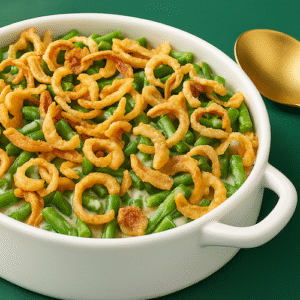Green Bean Casserole: How a Simple Side Became a Thanksgiving Icon

Thanksgiving is rapidly approaching, and like most American families, we’ll soon be in the kitchen for hours preparing what can only be described as an ostentatious display of abundance—the year’s most gloriously excessive meal. By the end of the day, even after sending “care packages” home with the kids and other guests, it will still take the wife and me a solid week—and probably a gain of ten pounds—to work through the leftovers.
Our table will host all the familiar favorites—roasted turkey, cornbread dressing (slightly modified), mashed potatoes, and candied yams—but it wouldn’t be Thanksgiving without my wife’s broccoli-mushroom pie and, of course, the classic green bean casserole.
 Now, if for some reason you’re not familiar with green bean casserole (and I can’t imagine how that could possibly be), it’s the dish that perfectly captures the American spirit of convenience meeting excess. It’s simple, dependable, and just kitschy enough to belong next to the turkey—a creamy, crunchy monument to mid-century ingenuity that still holds its own on the modern table.
Now, if for some reason you’re not familiar with green bean casserole (and I can’t imagine how that could possibly be), it’s the dish that perfectly captures the American spirit of convenience meeting excess. It’s simple, dependable, and just kitschy enough to belong next to the turkey—a creamy, crunchy monument to mid-century ingenuity that still holds its own on the modern table.
Most historians agree that green bean casserole was the creation of Dorcas Reilly, a home economist with the Campbell Soup Company, in 1955. But, as with many mid-century American food legends, there’s a story behind the story. Some say the project landed on Reilly’s desk thanks to a request from the well-known Associated Press food editor Cecily Brownstone—a woman whose columns shaped what millions of homemakers cooked in their kitchens.
It seems that Brownstone—a Jewish, Canadian-born New Yorker—was writing a piece for her syndicated column about a dinner she attended at the Florida home of citrus magnate John Snively Jr. During the meal, Mrs. Snively served a green bean dish that captivated everyone at the table—so much so that she mentioned having served it to the shah and queen of Iran during their recent visit. Brownstone knew the story would delight her readers but needed a recipe to go with it. So she made a call to Campbell’s for help—and the rest, as they say, is history.
 The criteria Campbell’s set for Reilly and her team were simple but ingenious in execution: create a dish that any home cook could make with what was already in the pantry, including the company’s cream of mushroom soup. At first, the team experimented with various combinations, including celery salt and bits of ham, but they finally settled on six humble, affordable ingredients—Campbell’s condensed cream of mushroom soup, milk, soy sauce, black pepper, green beans, and a handful of pre-packaged French-fried onions. The result was a dish originally called Green Bean Bake—something that could be stirred together in a minute, poured into a casserole dish, and popped in the oven for 25 minutes flat.
The criteria Campbell’s set for Reilly and her team were simple but ingenious in execution: create a dish that any home cook could make with what was already in the pantry, including the company’s cream of mushroom soup. At first, the team experimented with various combinations, including celery salt and bits of ham, but they finally settled on six humble, affordable ingredients—Campbell’s condensed cream of mushroom soup, milk, soy sauce, black pepper, green beans, and a handful of pre-packaged French-fried onions. The result was a dish originally called Green Bean Bake—something that could be stirred together in a minute, poured into a casserole dish, and popped in the oven for 25 minutes flat.
Reilly’s creation wasn’t intended as a Thanksgiving dish at all, but rather a quick, comforting side for busy weeknights. Even though it appeared in Cecily Brownstone’s Associated Press column, it didn’t take off right away. That changed in the 1960s, when Campbell’s renamed it Green Bean Casserole and began printing the recipe on every can of cream of mushroom soup, as well as in promotional pamphlets. That’s when it truly found its place at the holiday table.
In 2002, Dorcas Reilly’s original recipe card was donated to the National Inventors Hall of Fame, where it now sits alongside other great American innovations—Edison’s light bulb, the telephone, and yes, a humble casserole that defined the taste of home. Reilly passed away in October 2018 at the age of 92, in her hometown of Camden, New Jersey.
 Today, green bean casserole continues to be a Thanksgiving staple, with an estimated 20 million American households serving it as part of their holiday feast. The recipe remains Campbell’s most requested—proof that sometimes the simplest things endure the longest.
Today, green bean casserole continues to be a Thanksgiving staple, with an estimated 20 million American households serving it as part of their holiday feast. The recipe remains Campbell’s most requested—proof that sometimes the simplest things endure the longest.
And every year, as we pass that bubbling casserole dish around the table, I think of Dorcas Reilly in her test kitchen, spoon in hand, unknowingly shaping a small but delicious part of American tradition. For all the fuss and feasting of Thanksgiving, it’s these familiar dishes—the ones made from pantry staples and a little heart—that remind us most of home.




